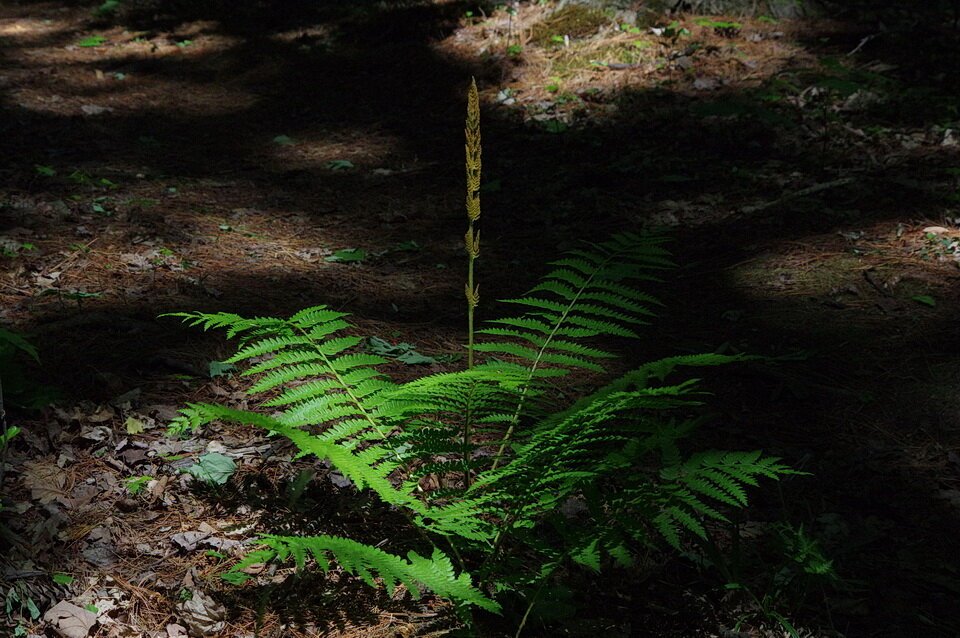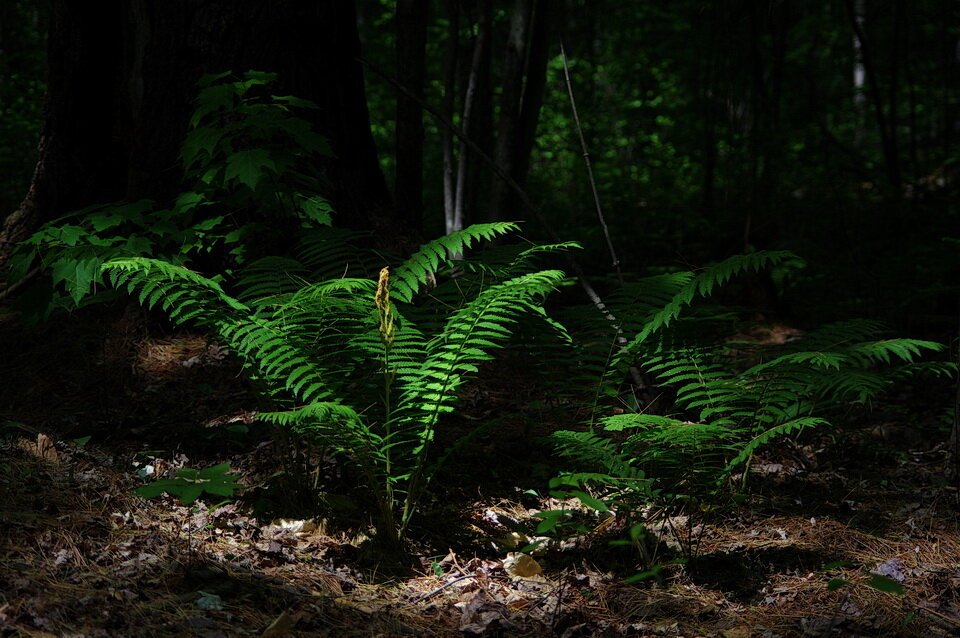Dinosaur Salad - Ancient Extant Ferns
In early June, in parts on North America, you might come across a large fern displaying a dramatic fruiting structure covered with cinnamon-coloured sporangia, while walking through shady forest on a moist, acidic forest floor. The forest light is moody and your first two thoughts might be “Jurassic Park” and “dinosaur food”! You are correct. This is cinnamon fern (Osmundastrum cinnamomeum) (Photo 1).
Photo 1: The ancient cinnamon fern (Osmundastrum cinnamomeum) appears to have remained in genomic stasis for at least 180 and likely at least 220 million years. Photo by Andy Fyon, Pinhey forest trail #32, Ottawa, Ontario, Canada, June 4/16.
History of Ferns:
Ferns have been around for a long, long time. In fact, about 360 million years ago, during a time geologists call the late Devonian period, ferns were the dominant vascular plant on the surface of the Earth. That was the time before dinosaurs, whose fossil remains first appear in rocks about 245 to 270 million years ago. The ancient ferns were around before, and during, the age of dinosaurs. Those ancient ferns were food for some dinosaurs.
Extant Modern Ferns With Ancient History:
Did you know that those ancient ferns have modern, extant, relatives? Today, many modern ferns grow in moist areas under forest canopy. However, the ancient ferns were a bit different than the ferns we see today - at least, some were different. Some ancient ferns were tree-like, some were winding, some were climbing, and some had epiphytic forms. It wasn't until about 145 million years ago, during a time geologists call the late Cretaceous period, that many modern, extant fern families started to appear.
A recent fossil discovery leads to the conclusion that several modern, extant ferns are direct survivors of the dinosaur days. One of those ferns is the cinnamon fern (Osmundastrum cinnamomeum) (Photo 1).
Korsaröd Fern Fossil:
The Korsaröd fern fossil from Sweden, described in 2014, sheds important light on the evolution of a group of ferns called royal fern family (Osmundaceae). The Korsaröd fern fossil is about 180 million years old. When alive, the fern grew during a time geologists call the Jurassic age. So, what is so special about the Korsaröd fern fossil?
Fossil preservation:
Normally, the process of transforming a dead life form into a fossil rock destroys fine cell structure. However, the remarkable Korsaröd fern fossil contains pristinely preserved cellular contents, including nuclei and chromosomes. Analysis of the morphological features of the cells in the Korsaröd fern fossil lead to the conclusion that: a) the number of chromosomes, as well as other properties of the DNA, matched an extant, modern-day fern that is quite common in eastern North America and Asia: cinnamon fern (Osmundastrum cinnamomeum); and b) neither ploidization (gene duplication) events nor notable amounts of gene loss occurred in the genome of the royal fern family (Osmundaceae) over the last 180 million years, since the Early Jurassic. Simply stated, the fossil evidence indicates that the royal fern family (Osmundaceae) remained in “genomic stasis”, virtually unchanged, for 180 million years, and likely at least 220 million years.
Cinnamon Fern Is Not Alone
Cinnamon fern (Osmundastrum cinnamomeum) is not alone or unique in its longevity. Antarctica rocks, which are 220 million years old (Triassic), contain fossils of the extant, modern-day interrupted fern (Osmunda claytoniana) (Photo 2 and 3) [C. Phipps et al. (1998): Osmunda (Osmundaceae) from the Triassic of Antarctica: An example of evolutionary stasis. Am. J. Bot. 85, 888 - 895.] Royal fern (Osmunda regalis) (Photo 4) is another member of the royal ferns (Osmundaceae) that shares this ancient lineage. So, it appears that Osmundaceae represents a notable example of evolutionary stasis among plants.
Photo 2 The ancient interrupted fern (Osmunda claytoniana) is another fern that appears to have remained in genetic stasis for at least 180 and likely 220 million years. Photo by Andy Fyon, Pinhey forest trail #32, Ottawa, Ontario, Canada, June 4/16.
Photo 3: The ancient interrupted fern (Osmunda claytoniana) is another fern that appears to have remained in genetic stasis for at least 180 and likely 220 million years. Photo by Andy Fyon, along the Wanapitei River, Killarney Highway, Ontario, Canada, May 26, 2012.
Photo 4: The ancient royal fern (Osmunda regalis) is another fern that appears to have remained in genetic stasis for at least 180 and likely 220 million years. Photo by Andy Fyon, Killarney Provincial Park, Ontario, Canada, July 5, 2008.
Dinosaur Food
So, the next time you come across cinnamon fern (Osmundastrum cinnamomeum), interrupted fern (Osmunda claytoniana), and royal fern (Osmunda regalis), tip your hat to these ancient survivors. They hung out with, and were salad for, dinosaurs as far back as 220 million years ago. They survived two, and likely three, global extinction events. Today, we get to enjoy their presence. And I predict, they will outlast our Homo sapiens presence on Earth!
May 28/21; Nov 17/21




